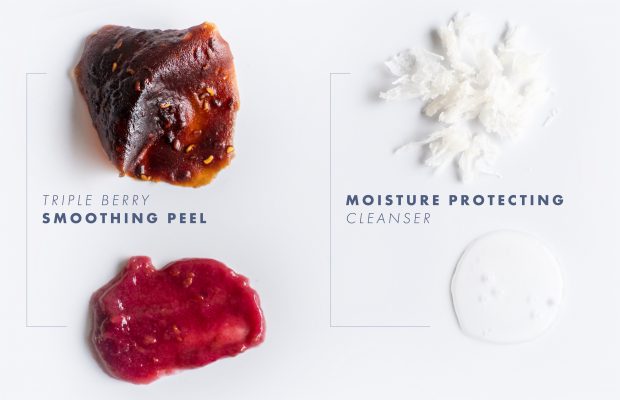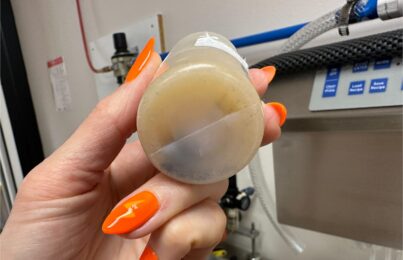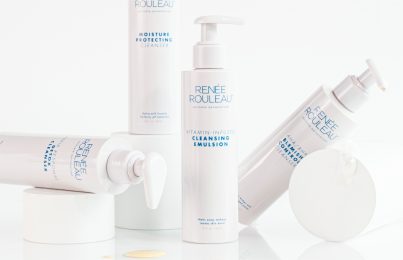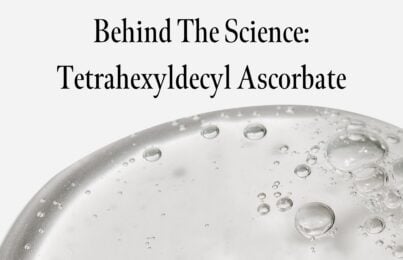Waterless skincare products have slowly been making their way into the market ever since rising to popularity in South Korea. Although the category of waterless skincare has only emerged in the last few years, some of the products it includes have always been inherently water-free. Many of them, like butters, balms, and facial oils, are oil-based instead. Some products circumvent water by compressing ingredients into bar form (you’ve probably seen cleansing bars making a resurgence of late). The most recent addition to the waterless category is powders. Performance ingredients, such as vitamin C or enzymes, are kept in powder form and activated by water at your bathroom sink once you’re ready.
Like everything else, waterless skincare is accompanied by marketing claims that can be confusing to navigate. In this post, I’ll break those claims down as well as explaining exactly what role water plays in your skincare products. Let’s dive in!
Am I Getting My Money’s Worth if Water is the First Ingredient in a Skincare Product?
One misconception is that water is a “filler” ingredient used to dilute skincare products and make them cheaper to produce. This is absolutely not true! Yes, water is inexpensive compared to most other ingredients, but that isn’t why it’s used. At the end of the day, it’s a necessary component of most successful skincare formulations, and there isn’t anything comparable that could be used in its place to get the same results.
So what exactly are those results? Here are some of the ways water enhances your skincare products:
- Acts as the main carrier in product formulations. This means that without water, all the other wonderful ingredients in your products wouldn’t be able to get into your skin where they’re able to make an impact. A lot of products (especially serums) also use penetration enhancers that are designed to help deliver active ingredients into the skin. Many of these penetration enhancers are made using water.
- Allows the use of certain active ingredients. Most (and I do mean most) active ingredients in skincare are water-soluble. This means they have to be dissolved in water in order to be “activated.” You wouldn’t be able to use your beneficial AHAs, peptides, and more without water!
- Enhances texture and usability. Texture is an undeniably important factor when it comes to skincare. A product may have all the right ingredients but if it doesn’t feel good on the skin, you’re probably not going to use it. Water is the number one way chemists are able to create products with beautiful textures. (As you can see in the photo above, I had samples of a cleanser and a peel from my line dehydrated. This isn’t a totally accurate representation of waterless products and how they’re made, but it’s a good visual demonstration of how important water is when it comes to the texture and usability of a product.)
How Much Water Should be in a Skincare Product?
It’s completely normal for water to make up anywhere from 70%-90% of a skincare formula. I know this sounds like a lot, but you have to think about it in terms of understanding ingredient percentages. For example, we all know retinol is one of the most effective and potent ingredients in skincare. This is despite prescription creams containing 0.1% at most! Much more would be far too irritating for most people.
All ingredients have an appropriate use level that makes them both safe and effective in a formula. Cosmetic chemists are well aware of these levels and the levels are often a lot lower than people expect, as I talk about in this post. Meanwhile, water is safe to use at any amount. It’s the perfect base thanks to its simple chemistry and the fact that it’s really stable all on its own. This means it’s unlikely to cause a negative reaction when mixed with other ingredients. All this to say, water is the real MVP when it comes to formulating skincare products and is so much more than just a “filler!”
Are Waterless Skincare Products More Potent? More Stable?
Generally speaking, waterless skincare products are more potent because they’re more concentrated. As you just learned though, more potent doesn’t always mean more effective. Most waterless products that contain highly-concentrated amounts of an ingredient, such as vitamin C powders, still need to be diluted with water before they can actually be applied to the skin. I can’t think of a single active ingredient I’d want to be applied on the skin at “full potency” and do worry about products like this being too strong or irritating. You also can’t really formulate with penetration enhancers when creating waterless products, so while the raw ingredient may be stronger it may also not be getting into your skin as effectively.
To tackle the topic of waterless skincare products and stability, let’s stick with the example of vitamin C powders. You may have heard that L-ascorbic acid is more stable in dry form than in liquid form, and this is true! Water is notorious for making vitamins unstable. Remember though that this is a relative statement. Powders with L-ascorbic acid are more stable than their liquid counterparts, but this doesn’t mean powders can’t oxidize—it just takes longer. You still want to make sure they’re stored in opaque, airtight packaging. I also worry that some companies aren’t including desiccants in their formulas so that the powder stays truly dry and protected from moisture in the air.
I love vitamin C as a skincare ingredient but am personally not a fan of L-ascorbic acid because it is so unstable. Instead, here are five things to look for in a vitamin C serum.
What About Preservatives?
Let me start by saying that the preservatives used in personal care products are well-studied and closely monitored, and I absolutely believe they’re safe to use (otherwise I wouldn’t formulate with them!). Beyond this, they help keep our products from growing bacteria, mold, and other organisms that can be harmful to our health. You can read more about my thoughts on preservatives, clean beauty, and the safety of ingredients in this blog post.
With that said, it’s actually not correct to assume that waterless skincare products don’t require preservatives. Even if you have a dry product like a powder, you have to consider the environment it will be in. All environments have some amount of ambient moisture in the air, and most products are stored in a bathroom—hello, humidity! This could cause unwanted organisms to grow, even in a “dry” product. Products like balms that are made up entirely of oils are also more prone to rancidity than most skincare products and need a system in place to prevent this.
Is Waterless Skincare More Sustainable?
While some aspects of waterless skincare can be more sustainable, you can’t really make a blanket statement saying it’s more sustainable than more traditional skincare products. Water is a huge source of energy, so if you’re not using it, what are you using in its place? If there isn’t any water in your formula, what are you using instead? Is it sustainably grown and manufactured?
Pros
One of the pros of waterless products is that they tend to take up less space than their liquid counterparts, so the packaging can be smaller thereby reducing waste. A waterless product might also take you longer to get through than a liquid product, so again, you’re reducing packaging waste by repurchasing less frequently. Another pro is that, without liquid, products tend to weigh less. This can reduce the carbon footprint of shipping them to customers.
Cons
Even if a finished product doesn’t contain water, the manufacturing process usually still requires water (and lots of it). Some waterless skincare products, like facial cleansing bars, are bound together by being exposed to high heat for a long period of time. This heat usually comes from tanks that are powered by—you guessed it—water. Water is also required to clean all the equipment used so it’s ready to go for the next batch. (These are only a few examples of how water is used during the manufacturing process but as you can see, it’s ubiquitous.)
You also have to consider what goes into the raw ingredients used in your products before they ever even make it to a lab or factory facility. For example, if your product is waterless by way of being oil-based, the footprint of growing the plants from which these oils are extracted can ultimately be greater than using water in your product.
Bottom Line
Any type of skincare will have its unique challenges as well as benefits, and waterless skincare is no exception. I wanted to write about this because I’ve heard a lot of sweeping claims made when, in reality, it isn’t all so black and white. This isn’t to say there aren’t some great, effective water-free skincare products out there but, like anything, you have to weigh the pros and cons and decide what’s best for you. I hope this post gave you the insight to do just that!
Celebrity Esthetician & Skincare Expert
As an esthetician trained in cosmetic chemistry, Renée Rouleau has spent 35 years researching skin, educating her audience, and building an award-winning line of products. Her hands-on experience as an esthetician and trusted skin care expert has created a real-world solution — products that are formulated for nine different types of skin so your face will get exactly what it needs to look and feel its best. Trusted by celebrities, editors, bloggers, and skincare obsessives around the globe, her vast real-world knowledge and constant research are why Marie Claire calls her “the most passionate skin practitioner we know.”



